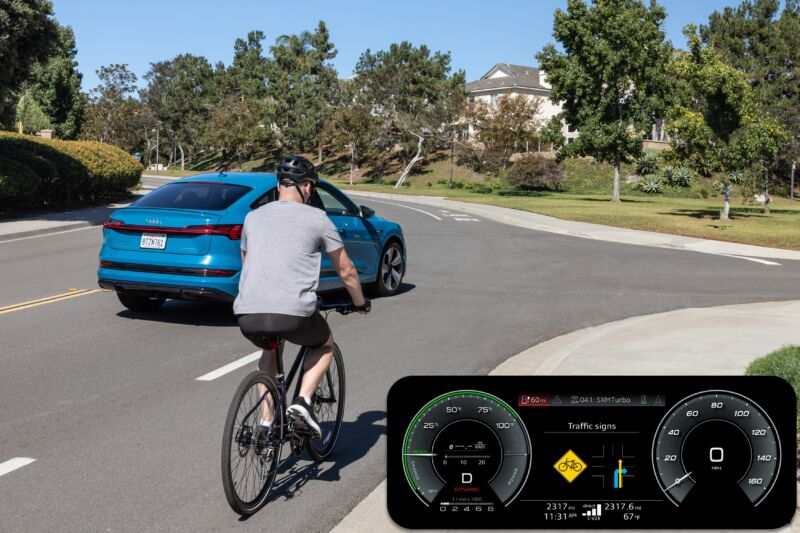
Audi
There’s a fundamental flaw in current car safety tech: it’s limited to line of sight. Or, perhaps, line of “sensing” is more accurate, because the way cameras and lidar work is to inspect the perimeter of a vehicle and use predictive algorithms to understand the motion of an object in relation to the motion of the vehicle itself. Which is good, because as carmakers have added elements such as pedestrian and cyclist detection, they’re trying to prevent drivers from hurting the most vulnerable road users. And unfortunately this is necessary, because even though 2023 saw a slight reduction in drivers striking cyclists and pedestrians, according to the most recent data from the Governor’s Highway Safety Association, since 2019 pedestrian fatalities are still up 14 percent—and cyclist deaths are up 50 percent since 2010.
That doesn’t mean lidar and cameras have “failed,” but because they rely on what the sensors can pick up, they cannot necessarily ID hazards (and alert drivers) as quickly as we need them to, particularly if that’s a cyclist in your lane 300 feet down the road, just over the next rise. Yes, current sensing works well now with figuring out the pace of a traffic jam, and automatic emergency braking can step in to stop your car if you fail to. But for non-automotive obstacles, they’re still limited.
For that, we need better tech, which is emerging and is called Connected Vehicle to Everything (C-V2X). The idea isn’t that complicated. Boiled down, it’s a chipset that operates on a portion of the cellular bandwidth, and vehicles with this tech embedded (say in an e-bike or car) monitor anything with a C-V2X chip as well as broadcast their own location at a pulse of 10 times a second. This precision location system would then warn a driver of a cyclist on the road ahead, even beyond line of sight, and in an emergency—possibly because a cyclist was right in a car’s path—could prevent a collision.
Pausing for a moment, you might assume that with 5G you wouldn’t need another system. A phone already has GPS, and you’d guess that directional prediction could be layered on via, perhaps, an app, since fitness apps already do this. But cell tower-to-tower accuracy has an issue: latency. When your call drops or a text doesn’t get through or the line gets a little scratchy, that’s a kind of glitch that could be fatal if the information that must be transmitted is your exact location in relation to a 2-ton pickup truck. Also: cell coverage isn’t ubiquitous.
“So with C-V2X, you don’t need Verizon or ATT or anything like that,” explains Audi’s Kamal Kapadia. Because it isn’t using the cellular network—it’s using a portion of cellular bandwidth to allow direct object, or vehicle-to-vehicle, communication. Audi has been working on C-V2X for nearly a decade, and it’s part of a group in the US called the Coalition for Cyclist Safety, which also includes suppliers like Bosch, a tech startup in the space called Spoke Safety, and bike brands such as massive Trek, parts supplier Shimano, more niche bikemakers like Switzerland’s Stromer, as well as mega telco suppliers and networks such as Qualcomm, Deutsche Telekom, and TELUS.
As for why this matters now, the FCC is about to solidify rulemaking and standards for this chunk of spectrum that would allow companies to use the system and that particular frequency for all sorts of purposes around safety. Brad Stertz, who manages government affairs for Audi, says that C-V2X beacons on EMS vehicles could be used to change a stream of “smart” stop lights “so the fire truck gets signal prioritization,” changing red lights congesting its path. “This doesn’t exist today, but it could, and that way you get a ‘wave'” of green lights, for emergency responders to get to an accident faster.
There’s another aspect, Kapadia explains, too: “That’s longer distance, and it’s sending a message we call safety-enhancing technology, where you’re giving the driver information to have an earlier opportunity to avoid an icy road or traffic congestion ahead.”
Bike brands jumping onboard
Mio Suzuki is Trek Bicycle’s director of embedded systems, “and we are exploring all sorts of safety,” she says. For instance, Trek recently introduced its own radar tail light, which warns riders of a car approaching rapidly—Garmin has had similar systems for several years. But Suzuki is intrigued by C-V2X because it offers more advanced warning than rear-facing radar. “And unlike cars, we have a very vulnerable road user so we need to augment our senses and the rider’s awareness of the riding environment, because we don’t have a big metal shield around us.”
What Suzuki envisions this direct communication might enable is an e-bike where the rider has a display that would warn a rider “of an imminent danger that’s approaching; a car might be coming from the side, but the view of the car is obstructed by a building, so the rider can’t see.”
Franz Reindl is CTO of Stromer, a high-end Swiss brand that only makes e-bikes with very top tech, including ABS brakes. Reindl says they’re also studying C-V2X. “Safety is one of our biggest promises, and we need to do everything we can with products and technologies to make it more safe for customers.”





















+ There are no comments
Add yours